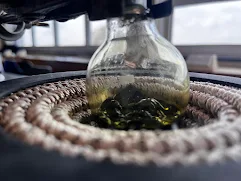I recently watched a film about the lawyer Erin Brockovich and how she successfully won a case against a company for water pollution - dumping hexavalent chromium, a carcinogen, into a town's groundwater. A large utility company, PG&E, had used Cr6+ in their cooling water to prevent their cooling towers from rusting, and this water was later disposed into the groundwater, which they did for several years from 1952 to 1966 without informing anyone. Only
forty years later, the legal case
was struck and they were held accountable - PG&E
supposedly don't use Cr6+ anymore. It's a good film, you should watch it, and made me want to learn more about hexavalent chromium [also written as Cr(VI) or Cr6+], which is what this post is about.
Chromium is a transition metal, which is a series of elements which can form ions with partially filled d orbitals. Take iron, which can lose two or three electrons to form either a Fe2+ or a Fe3+ ion, amongst various rarer ions. Whilst this difference doesn't appear too significant on paper, the compounds formed from these ions can vary by structure and, most notably, by colour (more on that in a moment), as well as by health risk.
Traditionally, as the number of electrons in an atom increases, it's linearly - one electron per orbital until each is occupied, before each orbital is filled again with another electron of opposite spin. This rule holds up until you reach chromium:
Titanium - 3d2 4s2
Vanadium - 3d3 4s2
Chromium - 3d5 4s1
Manganese - 3d5 4s2
The pattern unexpectedly breaks, with chromium having only one electron in its 4s orbital, and something similar occurs with copper down the line. This is partially to do with the spin of electrons; simply put, all electrons have a spin of either 1/2 or -1/2, and if two electrons are in one orbital, that means the spins cancel out - yet chromium avoids this by having all the valent orbitals occupied by just one electron, thus maintaining the electron spin. This in turn makes chromium more stable, especially as each orbital is filled.
Chromium atoms can form various ions with different charges, first losing its stray s electron before each d orbital gets emptied, and can thus form ions of charges 1+ through to 6+ (as well as a few rare negatively charged ions). The most common ions are Cr2+, Cr3+, or Cr6+. Cr2+ is relatively rare in nature, forming blue compounds, whilst Cr3+ is the most abundant in nature; its compounds are green. The latter - Cr6+, forming orange compounds - is the only one with a Wikipedia page, though isn't too common in nature either. Instead, it's been heavily produced on an industrial basis, which is unfortunate considering the health risks. The US releases up to 970 tonnes of Cr(VI) annually, due to burning coal and oil, the use of fertilisers, and leather tanning, amongst other factors. However, that figure was nearly 136,000 tonnes back in 1985. There are laws and regulations in place attempting to manage how much Cr(VI) produced, though the extent of these laws varies by country, all with different acceptable limits of Cr(VI) usage.
Cr(VI) will also bond with oxygen and form various ions - chromate (CrO42-) and dichromate (Cr2O72-). They're also not found naturally, with the odd mineral such as crocoite having chromate ions. Vincent Van Gogh's Sunflowers derives its yellow pigment from lead chromate. In industry, they are used to control corrosion, in leather tanning, as well as to produce chromic acid, used in ceramic glazing (and once in hair dyes). Unfathomably, they even let teenagers use these compounds in classrooms.
To oxidise alcohols, you can use potassium dichromate (K2Cr2O7) as an oxidising agent, and I happened to do this a while back. Quoting the hazard list I had to write up for the practical, potassium dichromate's risks are:
Toxic if swallowed
Causes severe skin burns and eye damage
Fatal if inhaled
May cause allergic skin reaction
May cause allergy or asthma if inhaled
May damage fertility or the unborn child
Causes damage to organs through prolonged or repeated exposure
Very toxic to aquatic life
Which is why you only add it in a fume cupboard. Reassuringly I only used it for a few seconds, and that was it. What looks like an appealing orange powder is instead a very toxic substance, and it being a powder increases the cancer risk through inhalation and spilling into fine grains on the floor.
The main aim was to oxidise alcohol to produce a carboxylic acid, and in the picture you can see a liquid bubbling as it's heated under reflux. The potassium dichromate itself is acidified, which enables this half equation to occur:
Cr2O72- + 14H+ + 6e- → 2Cr3+ + 7H2O
The H+ ions are necessary as otherwise the final products would be very unstable, hence the need to acidify the dichromate. The Cr3+ ions give the liquid its green colour, as opposed to the appealing orange associated with the Cr2O72- ions.
Cr(III) ions luckily have no associated health risk, indeed chromium is considered to be a key nutrient in one's diet in the US (less so in the EU). That makes Cr(VI) the odd one out - yet many transition ions are similarly harmful. Lead and mercury's health effects have been known for many years, and many heavy metals like chromium can produce harmful ions, especially if they end up in our soil or water. As is often the case in chemistry, many elements can seem contradictory - both healthy and harmful to us.

Well done‼️Bravo‼️
ReplyDelete